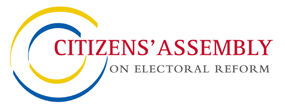 |   | Click for Search Instructions |
| Home > News & Events > CA Newsletter |
|
|
Newsletter - #1628th September, 2004 :
Vancouver (Internal)
Building electoral system contenders
Members of the Citizens' Assembly began this past weekend to
design "ideal models" of potential new electoral systems that they
think could suit BC.
After designing these alternative systems, the members will pick
the best, then compare it to the current "First Past the Post"
system. October 23-24, they expect to decide which
system – current or new – to recommend.
This past weekend, members brainstormed a Single Transferable
Vote (STV) model. When they next meet, October 16-17,
they will focus on engineering a mixed system model.
But, as chair Jack Blaney put it, "Nothing is decided until
everything is decided."
STV aims to make the legislature more "proportional", with each
party's share of seats roughly reflecting its share of the popular
vote. If STV were adopted, electoral districts would be combined to
create larger ridings with two or more MLAs per riding.
STV uses the preferential ballot which allows voters to vote for
more than one candidate by ranking candidates on the ballot
according to their preference – 1, 2, 3, and so
on. Ballots are counted in a way that ensures the
candidates with the highest preferences are elected.
Members said candidate names on the ballot should be grouped in
random order under party labels. And the random order
should rotate – meaning there would be multiple
versions of each ballot – so no candidate would always
get a favoured spot on the list. (This is called Robson
Rotation.)
Assembly members favoured no more than 3 MLAs for Northern and
remote ridings, and as many as seven in dense urban areas. Riding
boundaries would have to be redrawn by a provincial boundaries
commission.
Some Northern Assembly members expressed concern about their
already large ridings becoming even bigger, and said this could
further weaken local representation by MLAs. Other members
suggested that having two or more MLAs could actually improve local
representation, as voters would have more regional members to call
about concerns and issues.
One proposal was for a hybrid system, using STV in populated
multi-member ridings, and Alternative Vote (AV) in single-member
rural ridings. There were concerns, however, that this might
"create two classes of voters".
Members decided that, when a seat became vacant, byelections,
like regular elections, would use the preferential ballot to elect
a candidate to that seat (AV).
If, in late October, members do recommend a new electoral
system, it will be the subject of a referendum for all BC voters in
the May 2005 provincial election. If voters approve a
change, it would go into effect for the 2009 election. However, if
the Assembly opts to stay with the current system, there would be
no referendum.
Deliberation meetings continue
The Assembly’s schedule of future meetings is:
These meetings are held at the Morris J. Wosk Centre for
Dialogue, 580 West Hastings St., Vancouver. All plenary
sessions are open to the public, but seating is
limited. Saturday meetings usually run from 8:30am to
5pm with breaks. Sunday sessions are usually held from
8:30am to 12:30pm.
British Columbians’ views
online
Over 1500 submissions to the Assembly are posted on the website
Decision-making critical path
Attached is a
document entitled “10 Decisions” which
evolved from and replaces the earlier “Critical
Path”. It outlines the process Assembly members expect
to use in coming to a recommendation by December.
|
| © 2003 Citizens' Assembly on Electoral Reform | Site powered by | Site Map | Privacy Policy |